Japanese Samurai
Introduction
Text-to-speech Audio
Samurai status was more a matter of class rather than of occupation. Whether male or female, if a person were born into a samurai family clan, he or she was automatically part of the ruling class, even if they had never picked up a sword. Some samurai men became scholars, monks, or administrators. Some samurai women joined Buddhist convents. They all had various duties, yet all were expected to train for their military role...
Samurai warriors were part of the hereditary military class that ruled Japan for 700 years from 1185 until 1868. They emerged after feudal landowners formed family clans for safety against roaming bandits. They needed warriors and hired their strongest men as samurai, meaning “those who serve.” Regional clans developed over time into a hereditary samurai class under a local leader called a daimyo and a military dictator called a shogun. Their military superiority relegated the emperor to a position of figurehead. This situation lasted until the Meiji emperor was restored to power in 1868. After heated resistance, samurai warriors were replaced by the imperial national Japanese army. The end of samurai rule coincided with the opening of Japan to trade with the modern world...
A samurai warrior would have worn a flexible suit of armor into battle. Its design was developed over the 700 years of samurai rule. This armor’s flexibility, which allowed free movement, was probably as important in battle as its protection. Japanese armor looks very different from the plate armor worn for 400 years by their medieval contemporaries, the knights in Europe. While European armor was designed for knights to fight with lances and shields from horseback, Japanese armor was designed as a response to using completely different weapons...
Click on the first image to enlarge the photos and see the slide show.
Images
Samurai armor doll located in the Rudy Room
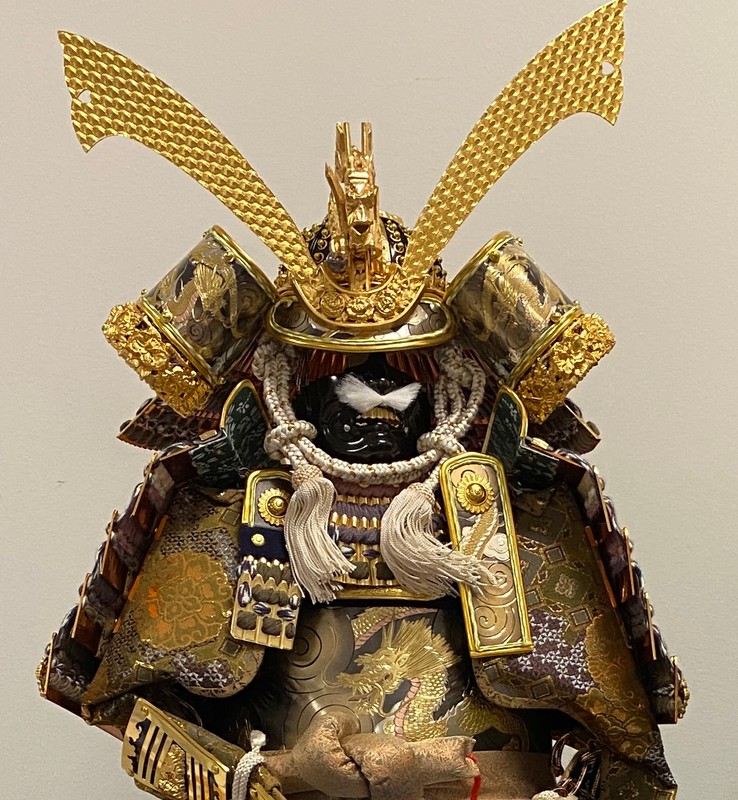
Samurai armor doll, sometimes displayed on Children's Day, May 5, as a symbol of strength and vitality
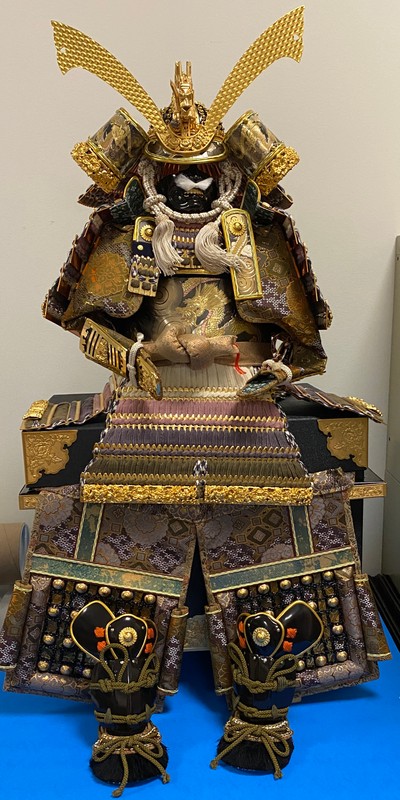
Life-size suit of flexible samurai armor with Kabuto helmet located in the foyer.
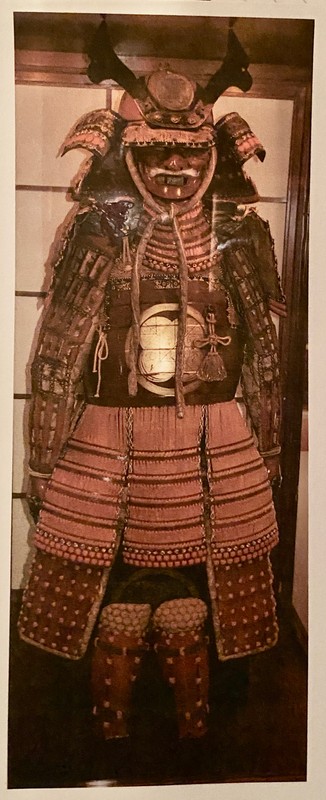
Samurai Kabuto helmet with elaborate metal sculpture between the two crests
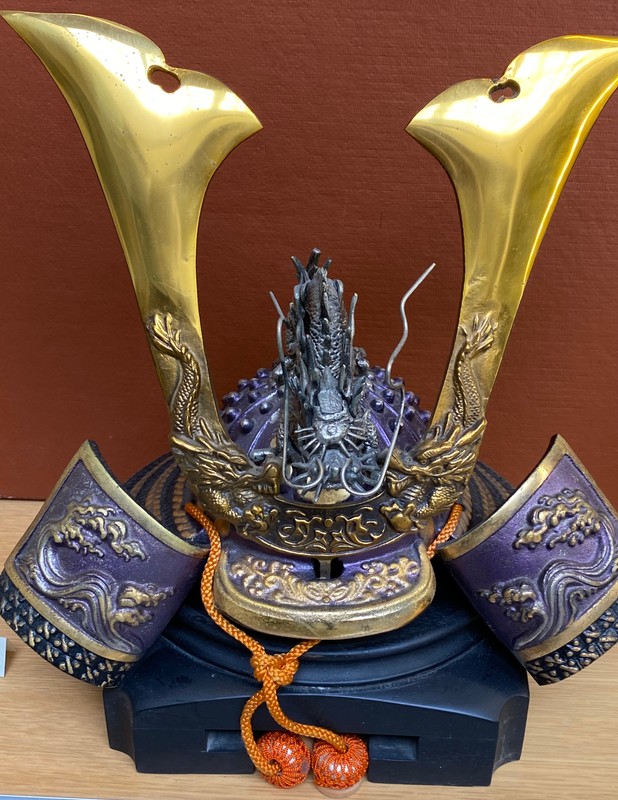
Kabuki actor depicts a samurai warrior with a longbow (Woodblock print by Utagawa Kunisada (Toyokuni III)
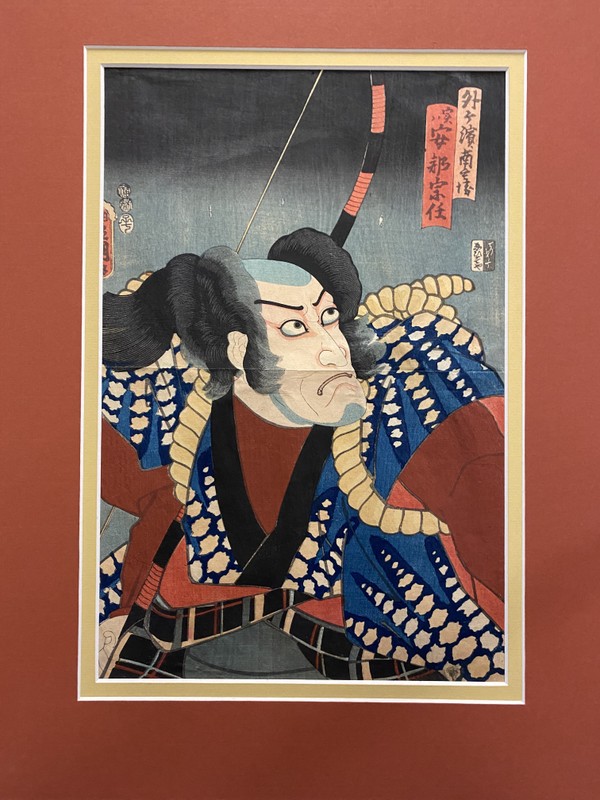
Kabuki actor playing a samurai with a long sword (Woodblock print by Utagawa Kunisada (Toyokuni III)
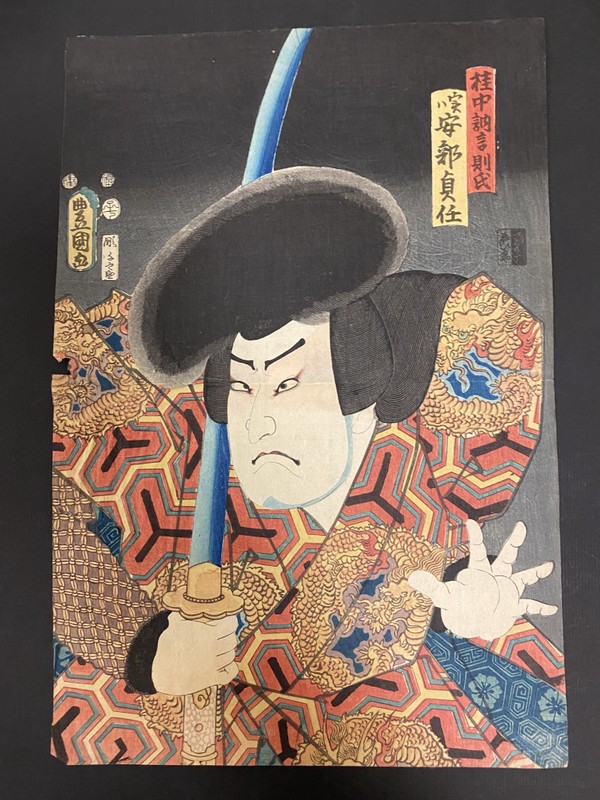
Underwater fight between two samurai warriors at the Battle of Yamazaki in 1582 (Woodblock print by Utagawa Yoshitora (1836-1880)
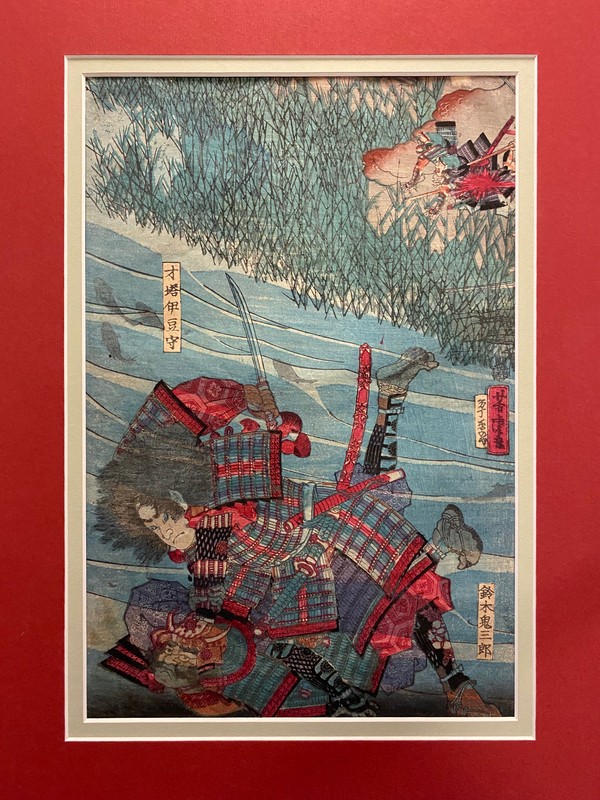
A scene from "The Tale of Genji" with Lord Genji outside his lover's yashiki mansion
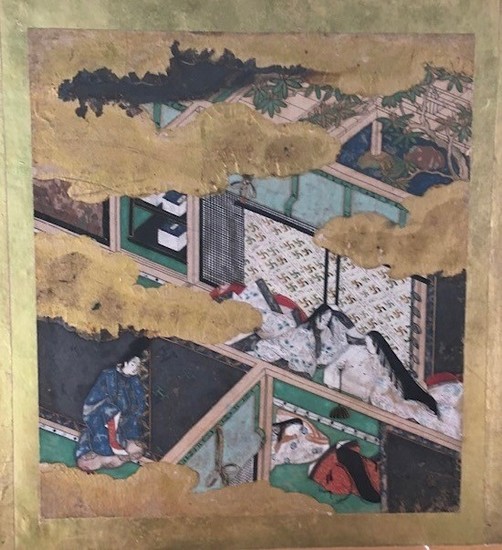
A scene in the daimyo's yashiki mansion seen through the "blown off roof" artistic convention.
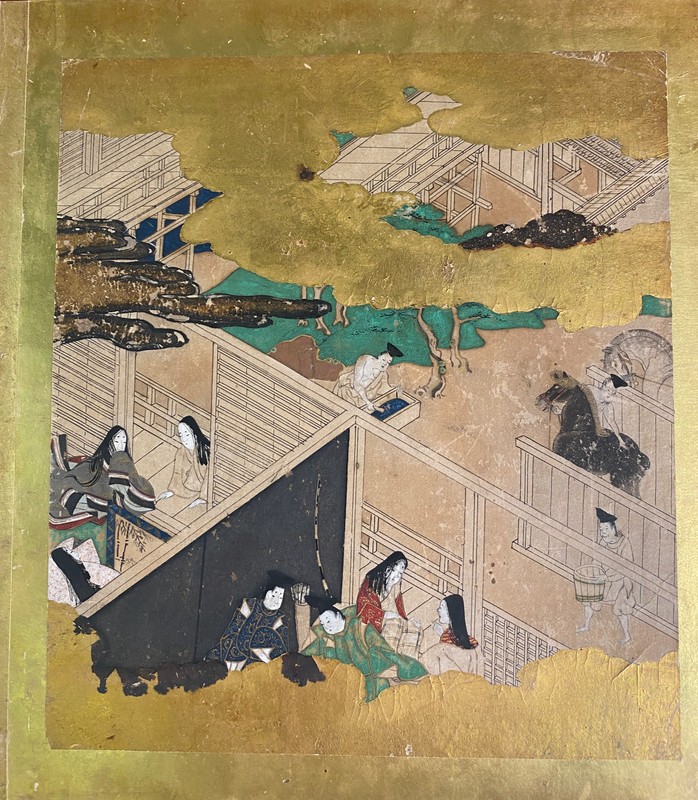
Kutani porcelain bowl depicts three samurai--one with with a masakari war axe, the second a yari spear, and the third a long katana sword.
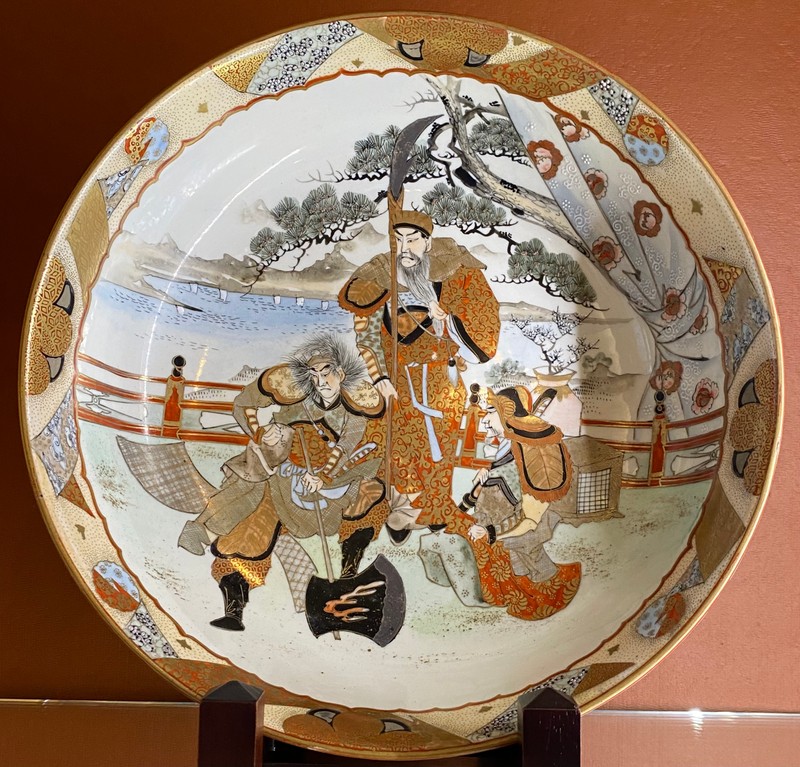
Samurai families enjoying the garden with Mt. Fuji in the background
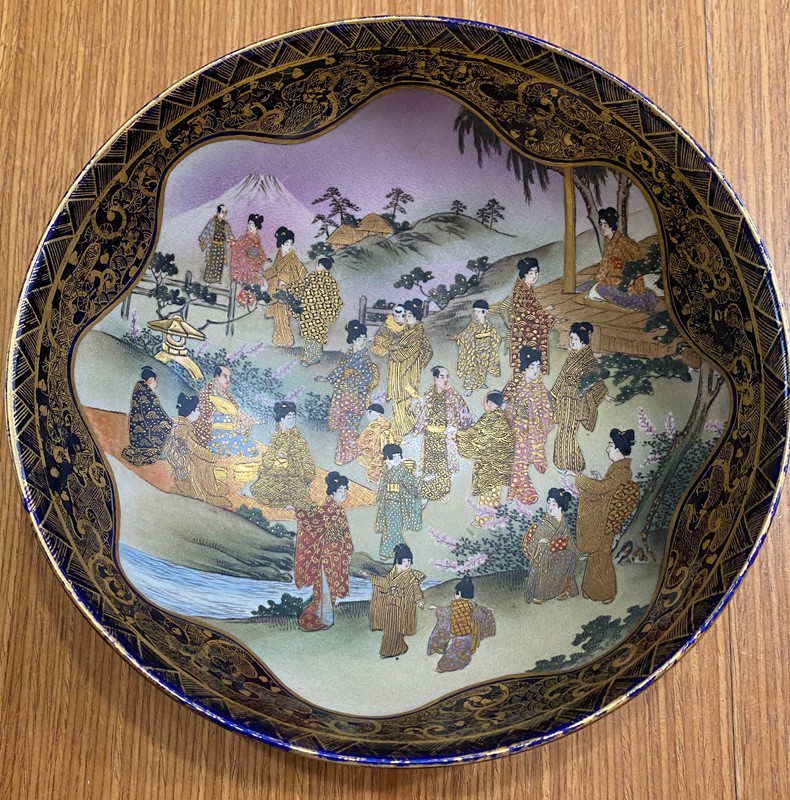
The legendary samurai wife who, after giving birth, donned her dead husband's armor and led the samurai soldiers to victory!
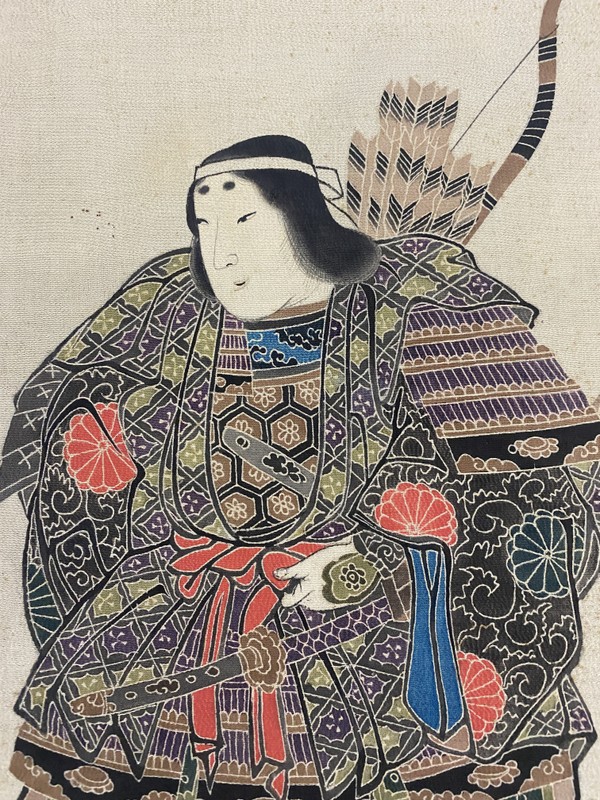
Retired samurai grandfather holding the newborn baby of the brave samurai wife
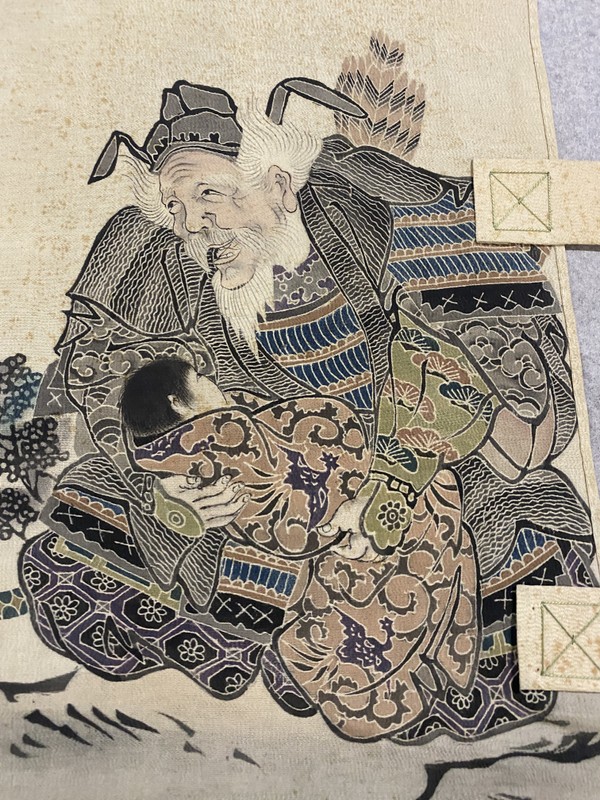
Samurai women with shaved eyebrows and black smudge marks, which indicated a married woman during the Edo period.

A samurai woman supervising the preparation of mulberry leaves for silkworms
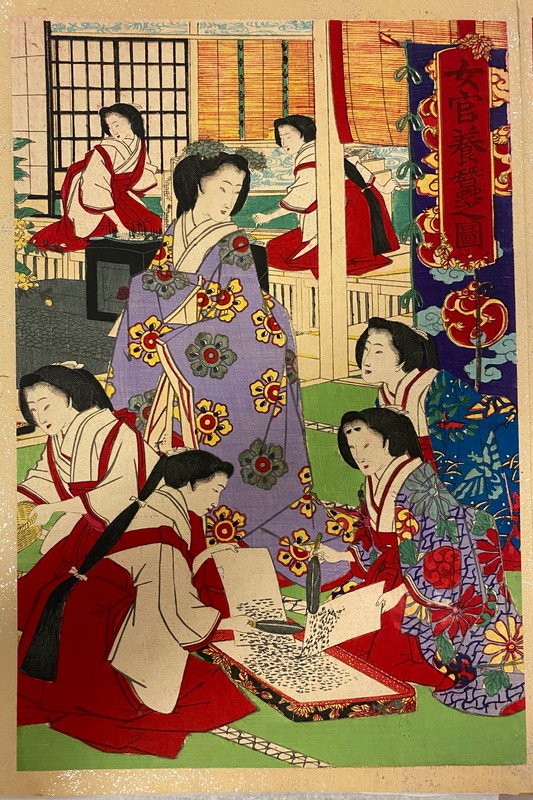
Some samurai traditions still live on
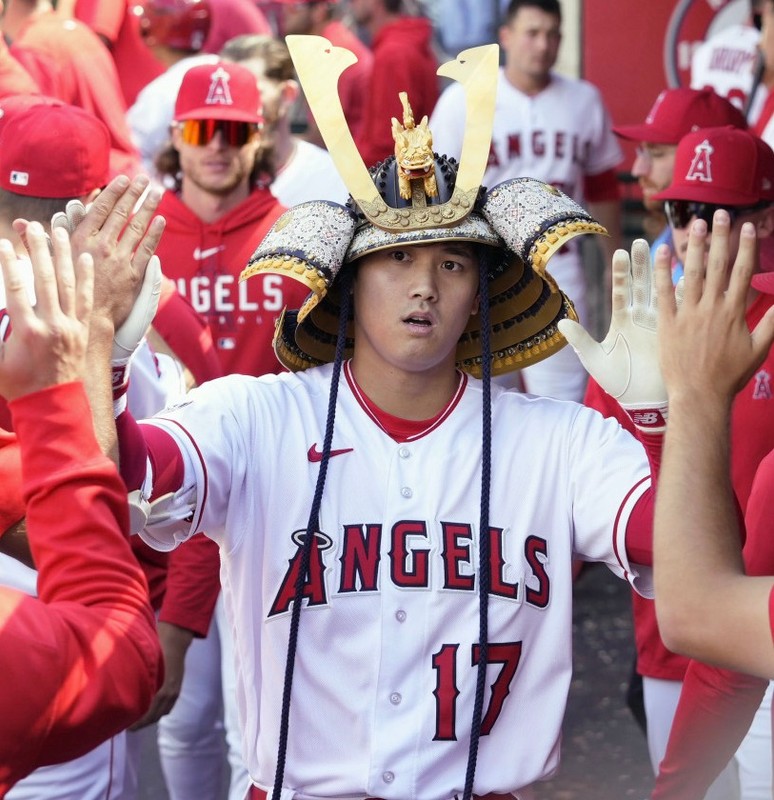
Backstory and Context
Text-to-speech Audio
Samurai Armor...
Flexible armor was made primarily of small scales of metal fastened together. They were lacquered to prevent rust, fastened to each other by cords to make horizontal sections, and then combined vertically by silk cords to allow the various sections covering legs and arms to hang suspended. Originally samurai armor was completely constructed of flexible plates, but solid plates were eventually added to cover the chest and back when spears were added to the samurai weaponry. These were further modernized as firearms became more prevalent. Some were decorated lavishly, but most were embellished with finely worked metal and leather pieces. The clan symbols were added to identify a samurai’s allegiance to his lord daimyo, a loyalty that required death over defeat. This was part of a simple set of shared values and came to be called bushido, “the way of the warrior...”
The Kabuto helmet is one of the most readily identifiable pieces of armor that a samurai wore. Riveted plates form the helmet bowl. At the top is a gilt rimmed hole. Its purpose is unclear. Many suggestions have been made, such as its use for burning incense in battle, but the probability is that it was simply easier to cut out the overlapping plates at that point rather than having to join them. Helmets also featured prominent crests on either side, frequently with imitations of horns as seen here. Additional decorative details could be added between them to indicate rank...
Usually the face was left unprotected, although half-masks were sometimes worn and full masks even less frequently. Some masks are part of the equipment as they serve to anchor the helmet. If it had belonged to a young samurai only 14 years old, the ferocity of the mask would also have helped to conceal his inexperience...
Samurai Weapons...
Surprisingly, the main weapon of the samurai was not his sword. All samurai carried two swords and used them to good effect, but in battle they did not rely solely on them. The armor’s flexibility was designed primarily to facilitate use of the deadly longbow from horseback. The longbow had to be held high to clear the horse’s head while the samurai twisted his body, loading and re-loading arrows from the quiver on his back. All of this could never have been done in solid armor! Early chronicles refer to the samurai role as “the way of horse and bow.” Only when the arrows were gone did the samurai dismount and become a swordsman...
The two swords that have traditionally come to define a samurai were a long steel katana sword of incredible sharpness and a short sword, or wakizashi, both carried at his left side. These two swords were worn at all times with few exceptions. Since only a samurai was allowed to wear weapons, these two swords were a clear indication of his status as a member of the samurai class...
Samurai Women...
What about the samurai women…were they warriors, too? Yes and no. They were trained in martial arts to use a small dagger to protect their personal honor even if it meant death. The dagger was kept in its case and tucked inside the obi. It was not hidden since it also served to declare their position, much as the two swords did for samurai men. Upper-class women also were trained to use the naginata (a long-poled weapon with an arched blade at the end) for a last-ditch defense of the home. This weapon provided greater reach than a sword and give it greater defensive capabilities. The naginata became the symbol of samurai women. Archery came into play only in castle defense. Although women seldom fought in battle, at times women armed with naginata patrolled the inner compounds. If the men were away, the wife may have commanded the castle’s soldiers. A few noble women did become onna-bugeisha, female warriors, and their stories became legends...
The role of women in the samurai class was generally one of subservience to men. Both Confucianism and the warrior values of bushido required male dominance over women. To maintain the social balance, a woman was expected to yield to her father and to her husband in all matters. With that in mind, 13th century laws did allow women equal rights of inheritance with their brothers. With husbands almost constantly away in combat, these early laws allowed women to control finances, bequeath property, manage servants, raise their children with proper samurai upbringings, and defend their homes in time of war. Their other duties also included preparing the troops for war by organizing provisions and weapons...
Samurai class women were as educated as samurai men. They were taught to read, write, dance, and perform the rigorous tea ceremony. A samurai wife was a highly respected companion to her husband. The role of women changed, however, when the Shogun Tokugawa unified Japan under his rule at the beginning of the Edo period (1600–1868). Their samurai husbands were no longer fighting wars but were working as bureaucrats. Now the upper-class wives were expected to stay at home and concentrate on the children’s education. Older ideals of fearless devotion and selflessness were replaced by quiet, passive obedience. The society became so regulated that only men were allowed to own property. Women were forbidden to travel without being accompanied by a man. There was a reappearance of the old custom of shaved eyebrows replaced by black smudges on the forehead, and married women blackened their teeth to identify their marital status. A woman’s role came to be viewed strictly in terms of child-bearing. Women were no longer seen as equal companions. Marriage-age daughters were often used as pawns in power struggles to broker deals, further reducing the influence women once held...
In 1945, women were given the right to vote in general elections and have continued to make strides toward equality. Today, many Japanese families have more balanced relationships. Nearly 40% of women work outside the home, and many fathers help with raising children...
Cite This Entry
STW on behalf of Assistance League of Long Beach. "Japanese Samurai." Clio: Your Guide to History. January 2, 2024. Accessed March 30, 2025. https://theclio.com/entry/171765/tour/3
Sources
Turnbull, Stephen. The Samurai. Osprey Publishing. New York: 2016.
“Japan: Memoirs of a Secret Empire. Samurai Woman” Devillier Donegan Enterprises. PBS. 2003. https://www.pbs.org/empires/japan/tokaido_6.html#:
Carnine, Douglas, et al. World History: Medieval and Early Modern Times. McDougal Littell, California Edition. 2006.
Scroope, Chara. “Japanese Culture: Family.” Cultural Atlas. https:/Culturalatlas.sbs.com.au. 2021. Accessed 15 August 2023.
Howard and Asian Art Collection Woodblock Prints, Ceramics, and other artifacts.
Kyodo News Image. May 10, 2023
Asian Art Collection 99.03
Asian Art Collection 99.03
Asian Art Collection 99.18
Asian Art Collection 99.46
Howard Collection 61.224 Woodblock Print by Utagawa Kunisada (Toyokuni III)
Howard Collection 61.226 Woodblock Print by Utagawa Kunisada (Toyokuni III)
Howard Collection 61.234 Woodblock Print by Yoshitora
Asian Art Collection 64.11 "The Tale of Genji" folio of woodblock prints.
Asian Art Collection 64.11 "The Tale of Genji" folio of woodblock prints.
Howard Collection 25.39
Howard Collection 25.06 Satsuma porcelain bowl
Howard Collection 77.23 Banner
Howard Collection 77.23 Banner
Howard Collection 64.10.17 Woodblock Print by Toshinobu
Howard Collection 64.10.16 Woodblock Print by Utagawa Hirokage
Kyodo News

